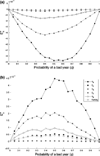Beyond the Mean: Sensitivities of the Variance of Population Growth
- PMID: 26635948
- PMCID: PMC4666685
- DOI: 10.1111/2041-210X.12010
Beyond the Mean: Sensitivities of the Variance of Population Growth
Abstract
Populations in variable environments are described by both a mean growth rate and a variance of stochastic population growth. Increasing variance will increase the width of confidence bounds around estimates of population size, growth, probability of and time to quasi-extinction. However, traditional sensitivity analyses of stochastic matrix models only consider the sensitivity of the mean growth rate. We derive an exact method for calculating the sensitivity of the variance in population growth to changes in demographic parameters. Sensitivities of the variance also allow a new sensitivity calculation for the cumulative probability of quasi-extinction. We apply this new analysis tool to an empirical dataset on at-risk polar bears to demonstrate its utility in conservation biology We find that in many cases a change in life history parameters will increase both the mean and variance of population growth of polar bears. This counterintuitive behaviour of the variance complicates predictions about overall population impacts of management interventions. Sensitivity calculations for cumulative extinction risk factor in changes to both mean and variance, providing a highly useful quantitative tool for conservation management. The mean stochastic growth rate and its sensitivities do not fully describe the dynamics of population growth. The use of variance sensitivities gives a more complete understanding of population dynamics and facilitates the calculation of new sensitivities for extinction processes.
Keywords: conservation; extinction; polar bears; population growth; population viability; sensitivity; stochastic matrix model; variance of population growth.
Figures







References
-
- Aberg P, Svensson CJ, Caswell H, Pavia H. Environment-specific elasticity and sensitivity analysis of the stochastic growth rate. Ecological Modelling. 2009;220:605–610.
-
- Beissinger SR, McCullough DR. Population viability analysis. University of Chicago Press; 2002.
-
- Boyce MS, Haridas CV, Lee CT. Demography in an increasingly variable world. Trends Ecol. Evol. 2006;21:141–148. - PubMed
-
- Caswell H. Matrix population models, vol. 2nd. Sunderland, USA: Sinauer Associates; 2001.
-
- Caswell H. Sensitivity analysis of the stochastic growth rate: Three extensions. Australian & New Zealand Journal of Statistics. 2005;47:75–85.
Grants and funding
LinkOut - more resources
Full Text Sources
Other Literature Sources
